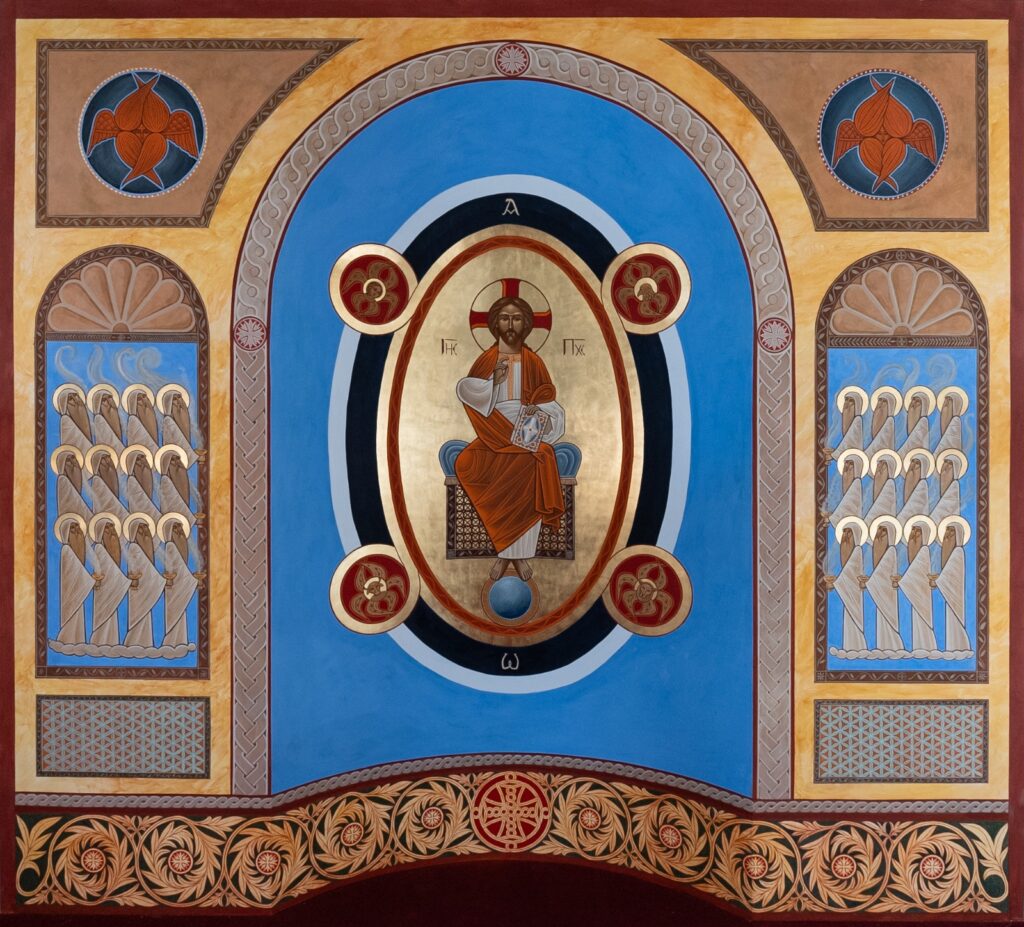At Jersey City, a Coptic Christian Community Rises, Along With Its Distinctive Ancient Iconography
This living tradition is being carried on by Professor Stephane Rene, who is currently painting a complete iconostasis and murals for the Coptic Orthodox Church of Saint Mark.

Egypt’s Coptic Christian minority, the largest in the Middle East, might not be a community one would associate with Jersey City. Due to an ongoing cycle of persecution and discrimination in the Egyptian Copts’ country of origin, however, Jersey City has become one of the largest such communities outside of their native land. With an estimated 15,000 parishioners in the city and 50,000 across New Jersey state, a quiet Egyptian Coptic Christian revival is underway just outside the five boroughs.
Along with this renaissance is a revival of an ancient Coptic Iconography. Visually similar to the iconography of the Greek Orthodox and other Oriental Orthodox churches, Egyptian Coptic Iconography is distinguished by its own distinct symbolism, though it borrows much of the aesthetics and materials of its neighboring schools. Now this living tradition is being carried on at Jersey City by Professor Stephane Rene, who is currently painting a complete iconostasis and murals for the Coptic Orthodox Church of Saint Mark on Westside Avenue.
Mr. Rene, who is originally from France and now based at London, is one of the only living Coptic Iconographers practicing this tradition into the present day. Studying under one of the last “Neo-Coptic” masters, Professor Isaac Fanous, Mr. Rene considers himself part of a living sacred arts tradition that spans, he says, all the way back to the church’s founding by Saint Mark in the year 64 of the common era. Mr. Rene completed his studies under Fanous at the Royal College of Art at London, eventually completing a doctorate.

Fanous is generally recognized as the originator of the “Neo-Coptic” style, incorporating traditional Coptic Christian symbolism but also containing nods to a modern and contemporary abstraction and use of space, as well as an emphasis on pan Egyptian identity. Most importantly, Fanous placed a strong emphasis on the interrelated nature of Orthodox theology, symbolism, and iconographic tradition, which he learned under noted Russian Orthodox iconographer Leonid Ouspensky at Paris during the 1960s.
Now in high demand, Mr. Rene flies around the globe to provide iconography for the growing number of expatriate Egyptian Coptic churches worldwide. He has been hard at work at Saint Mark’s for the last three months and imagines that another few months will complete it.
It’s an extremely daunting task, involving depictions of all twelve apostles, biblical scenes, as well as large scale murals. Mr. Rene is the guiding hand behind the composition and the lion’s share of the artwork, which he manages with the help of assistants Daniel Wild-Corbett and Calum Rees-Gildea. He is also assisted by his former Royal College of Art Colleague and artist Amina Ahmed.
Mr. Rene, a slender, unassuming man with a traditional Coptic beard and gentle smile, shakes his head at the prospect of the work ahead. Traveling with his wife, with whom he converted some 40 years ago, he appears to be pleasantly astonished at having found his vocation. He receives me outside the church complex on Jersey City’s Westside Avenue.
There is the old cathedral, the first in North America, built by Egyptian immigrants in the 1960s. Next to it is a new, recently built complex and community center, the Emmanuel Center, the top floor of which is where the growing congregation currently worships. This is where Mr. Rene has been steadily painting in hopes of completing the church interior.
That Mr. Rene is in demand is no surprise. His murals and icons, painstakingly painted in traditional egg tempera on wooden panels or dry plaster — a technique known as “secco” — radiate an unmistakable solemnity and intensity. Yet there is a definite geometrical sharpness and relief that recalls the work of more contemporary muralists. Standing in relief against their gold backgrounds, the effect is one of contemplative serenity difficult to find in any contemporary painting elsewhere.
Much painting remains to be done, but Mr. Rene has already completed an imposing central mural of Christ, traditionally known as the “Pantocrator,” or Christ returned triumphant as “ruler of all.” He sits flanked by symbols of the four evangelists, Mathew, Mark, Luke, and John. The presence of the Christ is imposing, the colors are resplendent. Bearded elders of the church flank his figure deferentially on either side.
The mural can be viewed through the central door of the iconostasis, which is the traditional Coptic wooden screen that spans the front length of the church, screening the sacristy from the congregation. This particular iconostasis, elaborately carved and imported from Egypt, is an imposing piece of floor to ceiling woodwork in which Mr. Rene’s icons are set like jewels in a crown.
There are already icons depicting Saint Mark, who is the founder of the Egyptian Coptic church at Alexandria, as well as depictions of Saint Michael the Archangel, and the Virgin Mary and the Christ Child. Eventually the Iconostasis will contain depictions of all twelve apostles and other biblical scenes. In his rendition of the archangel Michael defeating Satan, the latter is represented by a greenish man with leathery wings. Saint Michael’s lance pierces his tongue, a pointed commentary on Mr. Rene’s theological views on the root of evil.
“Iconography belongs firmly in the school of symbolism” he explains. “Giotto was probably the last great practitioner of iconography in the West. The emphasis was not on realism at all. After, with the introduction of perspective and the anatomical human figure, however, the shift away from the symbolism of iconography towards Renaissance humanism began.”
In terms of practice, Mr. Rene does not believe that the practice of his art is in any way distinct from other forms of ecclesiastical practice and discipleship. He states plainly that his art is one of many paths of Christian devotion which demands the artist become entirely dedicated to the embodiment of sacred ideas of proportion, beauty, and symbolism. As such, his artistic practice is distinct and inseparable from the demands of his faith.
What is striking about this work is how it decidedly runs against the grain of modernist and contemporary painting. Whereas contemporary painting, in its finest moments, is about open-ended investigations into the nature of seeing, framed by a distinctly conceptual, secular philosophical view, these icons are by contrast self-contained and modest microcosms of theological order.
They are aimed at keeping the confusion and squalor of fallible humanity at bay, and they do so through their dense interweaving of symbolism, theology, and biblical exegesis. One tug at the intricate symbolism that holds them together and the radiance inside them would collapse. As such they are tributes to the fragility of goodness and the Christian way of life. That they can be found in the heart of working-class New Jersey is just one more tribute to the incredible resilience and diversity that mark the American experiment, even in our fractious present day.

